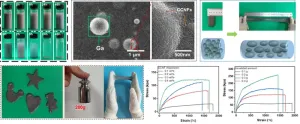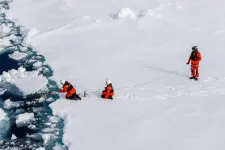USTC realizes light-driven programmable colloidal self-assembly
2023-04-21
(Press-News.org)
Prof. PENG Chenhui's team from the School of Physics, University of Science and Technology of China (USTC), realized the collective transfer and reconfigurable self-assembly of colloidal particles by combining the light-driven molecular motors with liquid crystal (LC) molecules in the nematic phase whose orientations are programmed with topological patterns and disclination networks. The work was published in Proceedings of the National Academy of Sciences of the United States of America on April 11th. Through light irradiation, the cooperative reorganizations of nanomotors induce collective dynamics of the disclination networks. The morphology changes of the disclination lines are utilized to transport and reconfigure the colloidal assemblies in translational, rotational, and programmable fashions. This work opens the door for future applications in micromachines and smart materials.
Nanomotors in nature have inspired scientists to design synthetic molecular motors to drive the motion of microscale objects by cooperative action. Light-driven molecular motors have been synthesized, but using their cooperative reorganization to control the collective transport of colloids and to realize the reconfiguration of colloidal assembly remains a challenge. In this work, topological vortices are imprinted in the monolayers of azobenzene molecules which further interface with nematic liquid crystals (LCs). The light-driven cooperative reorientations of the azobenzene molecules induce the collective motion of LC molecules and thus the spatiotemporal evolutions of the nematic disclination networks which are defined by the controlled patterns of vortices. Continuum simulations provide physical insight into the morphology change of the disclination networks. When microcolloids are dispersed in the LC medium, the colloidal assembly is not only transported and reconfigured by the collective change of the disclination lines but also controlled by the elastic energy landscape defined by the predesigned orientational patterns. The collective transport and reconfiguration of colloidal assemblies can also be programmed by manipulating the irradiated polarization. This work provides opportunities to design programmable colloidal machines and smart composite materials.
In the study, the team also elucidated how the pre-designed topological defects control the motion mechanism of colloidal particles on the disclination lines, which is determined by the elastic properties of the local pre-designed unfolding and bending deformation of liquid crystals. Thus, the physical mechanism of this light-driven programmable colloidal self-assembly lies in the cooperative reorganization of the nanoscale molecular machines by light, and the interaction of the molecular machines with the liquid crystal molecules is used to control the change of the nanoscale liquid crystal molecular orientation. Due to the long-range ordered nature of the liquid crystal molecules, a change in the orientation of the surface macroscale liquid crystal molecules is triggered. This macroscopic change further drives the change of liquid crystal microstructure inside the sample through surface anchoring, thus enabling macroscopic-scale reconfiguration toward disclination networks and colloidal self-assembly.
Jane FAN Qiong
Tel: +86-551-63607280
E-mail:englishnews@ustc.edu.cn
END
ELSE PRESS RELEASES FROM THIS DATE:
2023-04-21
The study was carried out in an animal model with oral administration of MNPs, in this case polystyrene, a widely-used plastic which is also found in food packaging. Led by Lukas Kenner (Department of Pathology at MedUni Vienna and Department of Laboratory Animal Pathology at Vetmeduni) and Oldamur Hollóczki (Department of Physical Chemistry, University of Debrecen, Hungary) the research team was able to determine that tiny polystyrene particles could be detected in the brain just two hours after ingestion. The mechanism that enabled them to breach the blood-brain barrier ...
2023-04-21
National University of Singapore (NUS) scientists have demonstrated that stepwise customised functionalisation of multihydrosilanes to access fully substituted silicon compounds can be realised using neutral eosin Y, an inexpensive dye molecule.
The development of a unified catalytic platform for stepwise and programmable functionalisation of multihydrosilanes is highly challenging. However, having this platform will facilitate the rational design of organosilanes with predictable functions, in which bespoke silane molecules are required. Three specific requirements ...
2023-04-21
According to a new Finnish study, greenness around the home in early childhood does not seem to protect children from atopic eczema. Instead, the proximity of coniferous, mixed forests and agricultural areas was associated with elevated risk of eczema. The effect was seen especially in children who were born in the spring.
“General greenness around the home did not protect children against eczema, which was contrary to our expectations and to the hypothesised allergy protective effect of nature contacts. Eczema is, however, only one of the allergic diseases in children, albeit generally the first to emerge,” says MD Minna Lukkarinen, a paediatric specialist from the ...
2023-04-21
A large-scale registry study in Finland has identified several factors associated with uptake of the first dose of COVID-19 vaccination. In particular, persons with low or no labor income and persons with mental health or substance abuse issues were less likely to vaccinate.
The study, carried out in collaboration between the University of Helsinki and the Finnish Institute of Health and Welfare, tested the association of nearly 3000 health, demographic and socio-economic variables with the uptake of the first COVID-19 vaccination dose across the entire Finnish population.
This work, just published in the Nature Human Behavior, is the largest study ...
2023-04-21
No single one practice is sufficient for greater innovation performance, say the researchers, overviewing the results of the most recent PDMA's 2021 global survey. The Best companies, according to the results, are better at employing multiple types of innovation, but the spend more time on radical innovation, are oriented towards risk-taking, and employ long-term strategies. The results were drawn from responses from 651 companies in 37 countries, the most extensive PDMA survey so far.
“I believe, we should fundamentally look ...
2023-04-21
A research team from Swansea University have been examining data from the year after the policy was introduced in March 2020, concluding that a “lack of clear impact on infection rates raises questions about the success of shielding.”
Shielding was introduced to protect those thought to be at highest risk of serious harm should they catch COVID-19, for example because of preconditions such as cancer or medications that they were taking. Key to protecting vulnerable people was to reduce their risk of contracting COVID-19.
The ...
2023-04-21
An unprecedented and continuing loss of biodiversity has been sparked by anthropogenic climate change together with the intensive use and destruction of natural ecosystems. However, since the public often views the climate crisis and the biodiversity crisis as two separate catastrophes, an international team of researchers including paleontologist Prof. Dr. Wolfgang Kiessling from Friedrich-Alexander-Universität Erlangen-Nürnberg (FAU) calls for adopting a new perspective: In their review study just released in the journal “Science”, they recommend protecting and restoring at least 30 percent of all ...
2023-04-21
This study is led by Dr. Wenxia Liu (State Key Laboratory of Biobased Materials and Green Papermaking, Qilu University of Technology, Shandong Academy of Science). To uniformly disperse LM into hydrogel, she conceived and designed using CCNFs rich in quaternary ammonium groups to encapsulate LM droplets through an approach of Pickering emulsion. “The strong electrostatic attraction and ion-dipole interaction between the quaternary ammonium groups of CCNFs and the hydroxyl groups on LM droplet surfaces were expected to prevent the LM droplets from aggregation and coalescence. The incorporation of CCNFs into hydrogel with the LM droplets was also expected to improve the mechanical ...
2023-04-21
Recently-published research from an international team of physicists reveals how the three-dimensional shape of rigid microscopic filaments determines their dynamics when suspended in water, and how control of that shape can be used to engineer solid-like behavior even when the suspension is more than 99% water.
The paper, “Bonded straight and helical flagellar filaments form ultra-low-density glasses,” was co-authored by Georgetown physics professors Peter Olmsted and Jeffrey Urbach and graduate student Matthew ...
2023-04-21
The alga Melosira arctica, which grows under Arctic sea ice, contains ten times as many microplastic particles as the surrounding seawater. This concentration at the base of the food web poses a threat to creatures that feed on the algae at the sea surface. Clumps of dead algae also transport the plastic with its pollutants particularly quickly into the deep sea - and can thus explain the high microplastic concentrations in the sediment there. Researchers led by the Alfred Wegener Institute have now reported this in the journal Environmental Science and Technology.
It is a food lift for bottom-dwelling animals in the deep sea: the alga Melosira arctica grows ...
LAST 30 PRESS RELEASES:
[Press-News.org] USTC realizes light-driven programmable colloidal self-assembly



